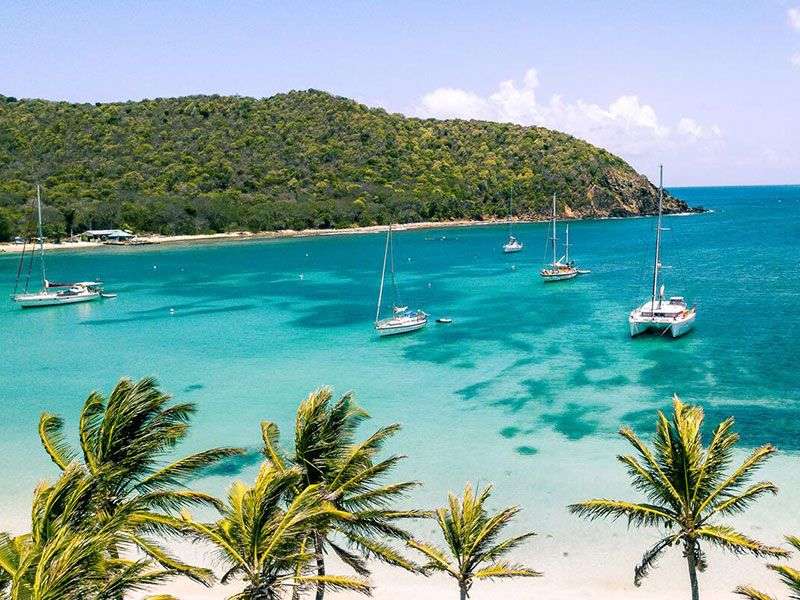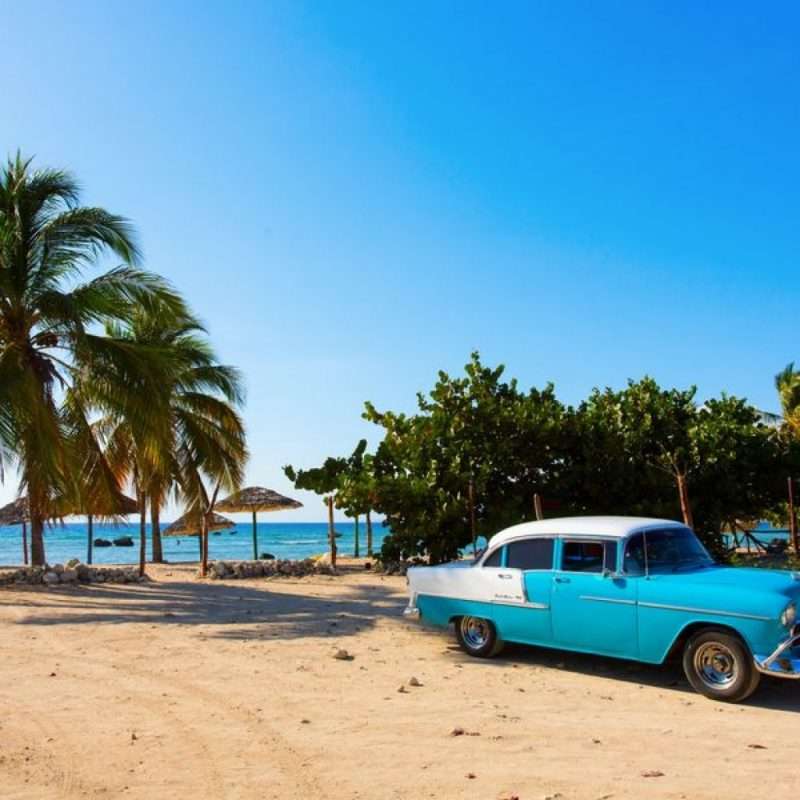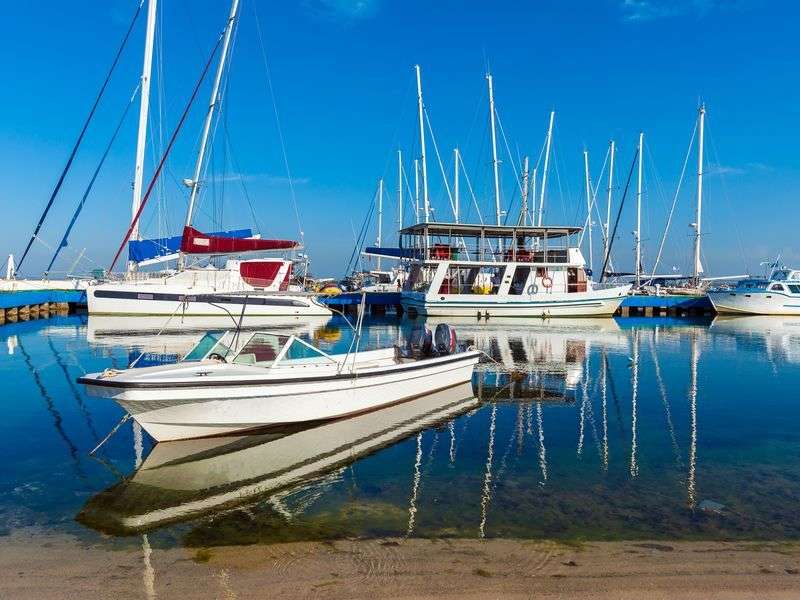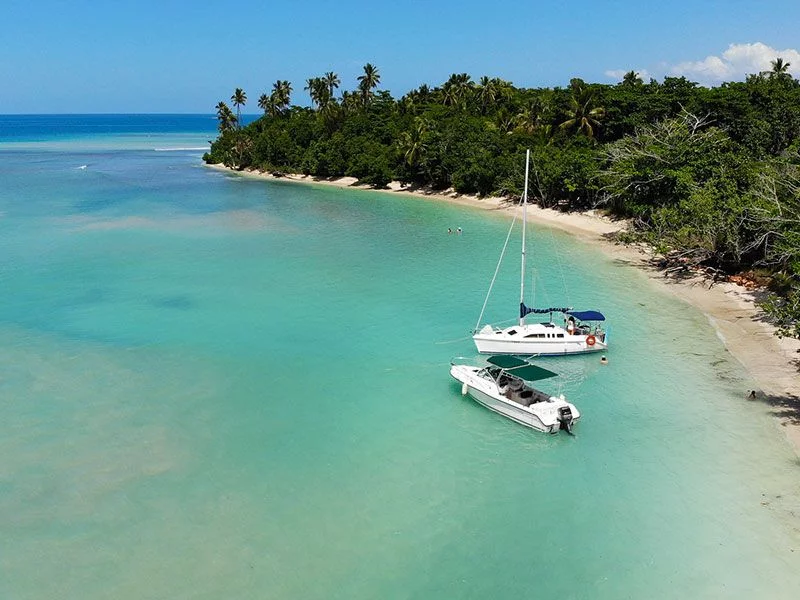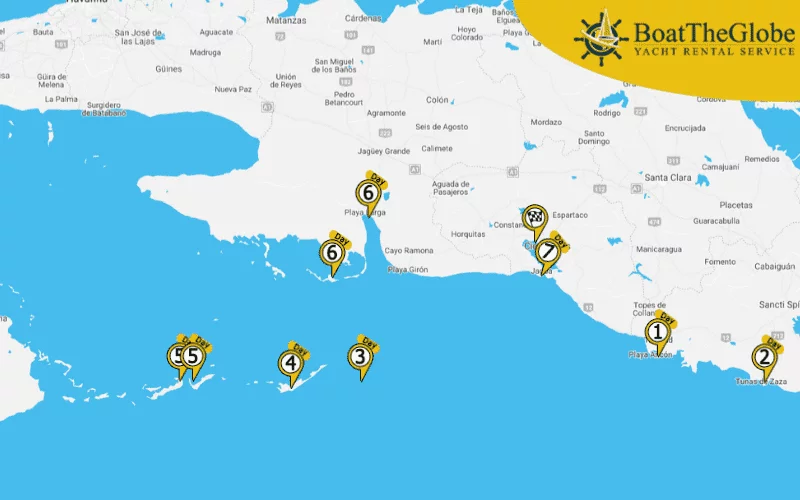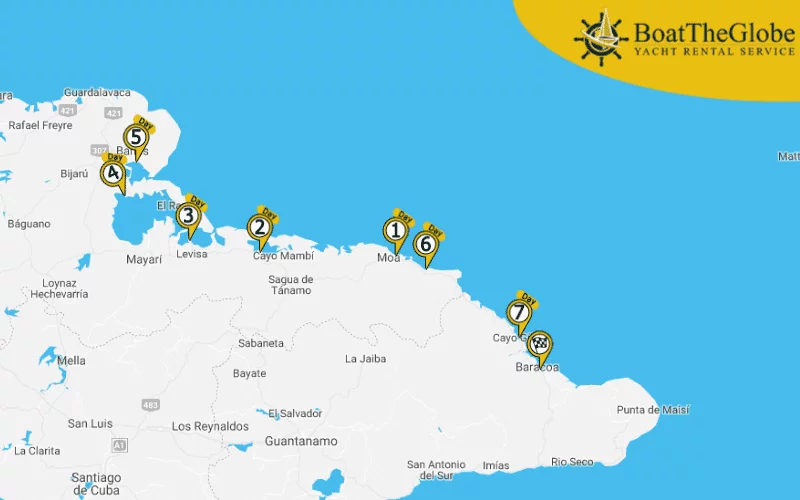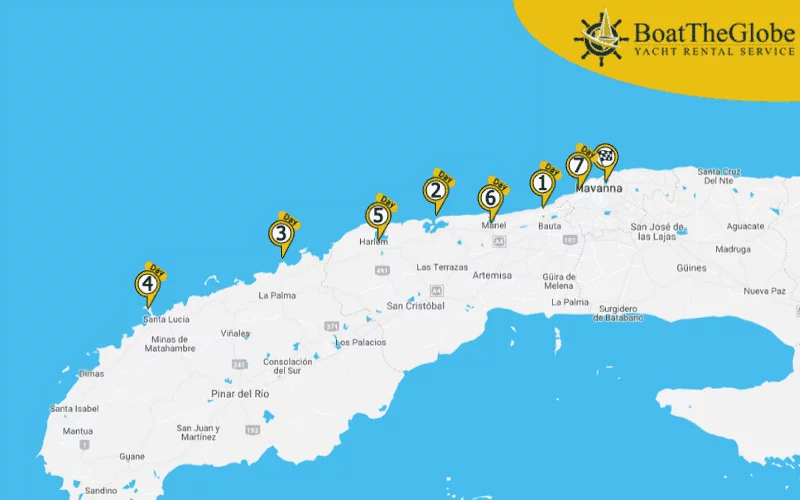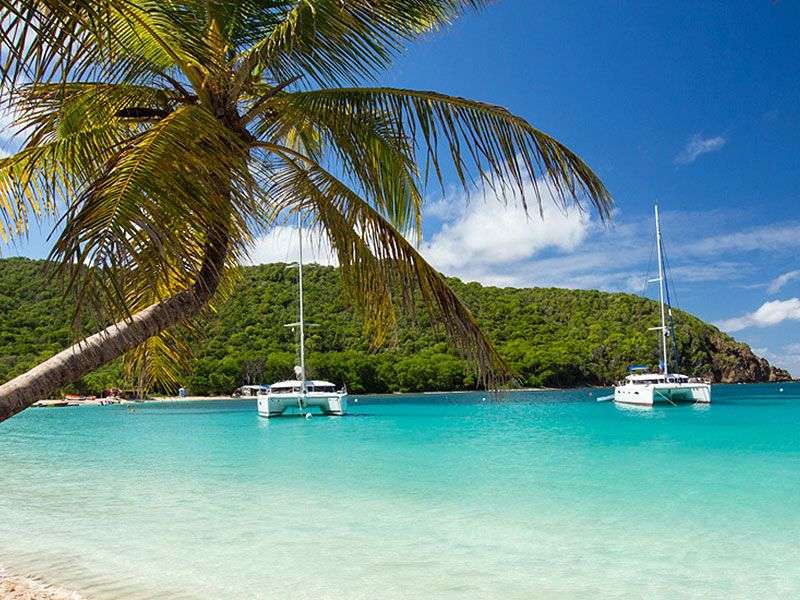Are you planning a sailing trip in Cuba? Is it safe? Explore the romantic bays and hidden sandy beaches. Do not hesitate – to begin your unforgettable journey right now! Tips and advice on how to make the best of your time while sailing in Cuba. This article will be the most useful read for those who want a comprehensive but friendly guide to the weather, routes, ports and attractions in Cuba.
This article gives an overview of the following topics:
- What is the best month to sail in Cuba?
- >Where to sail in Cuba? – ports and islands
- Sail in Cuba! Cuba sailing and catamaran tours
- Sailing in Cuba: Our offer for a one-week-long sailing round trip
- Sailing around Cuba: A 1 week Northeast Cuba sailing trip
- Cuba sailing holidays: 7 days North Cuba yachting
What is the best month to sail in Cuba?
Cuba has a tropical climate with warm temperatures year-round. The Dry Season (November to April) is the best time for sailing, with less rain, lower humidity and more predictable winds. The Wet Season (May to October) sees higher humidity, more rain (often short, heavy showers) and a higher chance of tropical storms. Although hurricanes are uncommon in Cuba, it is essential to be aware of the potential risks and monitor the weather forecast closely during this period. Constant trade winds blow from the east and northeast, generally providing comfortable sailing conditions. Winds are typically stronger in winter (10-15 knots) and lighter in summer (5-10 knots). The sea is generally calm, especially within the sheltered waters of the Cuban archipelago. However, conditions can get rougher on open water or during storms. Water temperatures are warm year-round, between 24 and 28°C. Check the sailing conditions and wind rose diagram of Cuba.
Is it safe to sail in Cuba?
Cuba offers a unique and immersive safe sailing experience and is cheaper than other Caribbean destinations, but there are some special situations that are better to be prepared for in advance. Navigating the Cuban bureaucracy can be a challenge, as there are numerous permits and paperwork required for both boats and crew. Sailing routes often need to be approved in advance, and there are restrictions on where you can anchor or disembark. Ports often have limited facilities. Due to increased boat traffic in recent years, for example, southern ports are busier. There are often waiting lists for berths. This is especially true for the popular Trinidad and Cienfuegos. So it is worth organizing your trip well in advance.
It is important to note that the country officially restricts moorings. The small bays on the north coast are closed to yachts. Landings are only allowed in ports or tourist facilities throughout Cuba. Some designated moorings are: Puerto Vita, Cayo Coco, Cayo Levisa, Marina Cabo San Antonio, Cayo Largo, Varadero. There are some exceptions to this even where there are no settlements. The strict regulation is related to the fact that approximately 22 percent of Cuba’s territory is national parks or nature reserves. Here, as in many places in the world, it is worth mooring your boat with the expected care and securing your valuables, especially at night. Obtaining fresh food and supplies can be a problem, which therefore requires planning and sometimes ingenuity.
Where to sail in Cuba? – ports and islands
The main Ports in Cuba
When sailing in Cuba, you may encounter special situations you should prepare for in advance. For instance, ports in the south are more crowded due to the vessel traffic that has increased in recent years. There is often a waiting list for marinas. This is especially true in Trinidad and Cienfuegos. So it is worth planning our trip and arranging our boat rental well in advance. It is important to note that there is an official limit on marinas in the country. Small bays on the northern shores are closed for yachts. It is only allowed to dock at ports or tourist facilities in Cuba. Some of the dedicated places are Puerto Vita, Cayo Coco, Cayo Levisa, Marina Cabo San Antonio, Cayo Largo, and Varadero.
There are a few exceptions in areas where there are no settlements. The strict regulations are in connection with the fact that 22% of the territory of Cuba consists of national parks or nature reserves. As in the case of many other countries, we should be careful about our valuables and docking our boats with reasonable care in Cuba as well. Rent a boat in Cuba and experience what it feels like when everything is perfectly timed – the sunset, the sea, and freedom.
Port of Havana
The largest port of Cuba is just a few km from the city centre. Boats can enter the port from the north through a short, straight inlet. It is divided into three parts: Marimelena, Atarés and Guanabacoa. The depth of the seabed is between 4, 6 and 11, 9 m. The port can accommodate larger boats. Due to its size, location and infrastructure, there are several commercial terminals. It is an important centre for fish, fuel and oil trade.
Port of Mariel
They started building the port of Mariel in 2009. The canal was dredged to 18 m (even deeper than the port of Havana) so Super-Panamax vessels can also use it. Enormous cruise ships can moor here, there are logistics centres, shopping centres and many entertainment options for tourists.
Port of Baracoa
It is located at the eastern end of Cuba. It is a well-protected port against winds. The canals are 22 m wide. The maximum depth of the seabed is 7, 6 m. The services include refuelling and water resupplying. It is a major port for sugar export.
Port of Cienfuegos
The main port in the southern part of the island is La Perla del Sur or the Pearl of the South. The port of Cienfuegos is considered a large port in Cuba. It can accommodate boats up to 150 m. The depth of the seabed is 12 m. While Christopher Columbus visited in 1494, it was formally founded in 1819. .
Port of Casilda
This small port is mainly recommended for local boats and smaller boats. The main attraction of this port is the nearby beach. It is less known, so you can relax in a peaceful environment. You should also visit the local restaurants that offer authentic Cuban specialities.
Port of Santiago de Cuba
The second-largest port city of Cuba is located in the southeastern part of the island, in Oriente Province. It is a major port for import and export in the region. The bay is quiet and protected against winds. The famous Casa del Habano is a few-minute walk from the port. Here, you can buy the best-quality Cuban cigars and you can visit the Bacardi Museum.
Port of Nuevitas
The port of Nuevitas is on the Guincho Peninsula. It is a smaller port and a major shipping point for sugar. The depth of the seabed is 9-10 m, the canals are 7-10 m wide. There are port elevators and cranes that work around the clock. The services include water resupplying and refuelling. However, boat maintenance is only available to a limited extent.
Small islands, atolls and coral reefs.
Many think that Cuba is one large island. This is not the case. The reason why the country is a popular sailing paradise is that the main island is surrounded by thousands of small islands. Coastal flows are formed around these islands, providing a chance for beginner sailors to gain experience, while the more experienced can still find a challenge here. We are going to describe the most interesting parts of the Cuban archipelago. The most beautiful parts and the finest spots in brief.
Isla de la Juventud – the largest
The second-largest island after the main one was named after the youth. We are 50 kilometres from the Cuban shores, in the centre of the Canarreos, south of Havana. A significant part is covered by pines, characterizing the view and the atmosphere. Due to the volcanic activity that was present several thousands of years ago, the shores of the island are covered by black sand. The island is a pleasant spot for tourists because of its climate. This is true regardless of the fact that sometimes hurricanes strike the place.
”Gardens of the Queen” – the unspoiled nature
The second-largest group of islands is located in the Caribbean Sea. There are six hundred reefs and small islands between the bays Ana Maria and Guacanayabo. The “Jardines de la Reina “is one of the most popular destinations for scuba divers. The waters surrounding the islands are rich in fish and sea creatures. That is why fishermen are common visitors in the area.
”Gardens of the Kings” – the world of beautiful corals
The archipelago called Jardines del Rey can be found on the northern shores. Coral islands and reefs lie about 200 kilometres long from northeast to southeast on the Atlantic Ocean. Half a dozen of these are larger and more significant in terms of tourism. Two of them are directly connected to the mainland (Cayo Coco and Cayo Guillermo). The islands provide a natural habitat for several animal species as the Caribbean flamingos which can be found in vast numbers here.
Sail in Cuba! Cuba sailing and catamaran tours
During our catamaran tour in Cuba, we have to prepare for longer distances and fewer ports. However, the beautiful Cuban islands will make up for it. We will find many undisturbed beaches and bays perfect for relaxing and swimming.
Sailing in Cuba: Our offer for a one-week-long sailing round-trip
We recommend Cienfuegos – the most popular charter of the country – as a starting point. We gave a more detailed insight about Cuba in our article on the sights in town. The port here is well equipped compared to what you would expect in the area. It may seem like a trivial fact, but many people here speak English, while in other ports the Spanish language might be your only option for communication.
Day 1. Cienfuegos – Casilda
78, 40 km (48, 72 nm)
On day one, you will leave Cienfuegos and sail towards Casilda. Approaching this small resort village, a real Caribbean atmosphere welcomes you: sparkling sunshine, a white sandy beach and palm trees. After mooring, visit a local restaurant and choose from an impressive selection of grilled fish and seafood dishes. The village’s white sandy beach is the perfect place to relax for a while. If you want to stay after dinner, enjoy an evening concert by local musicians accompanied by an authentic Caribbean cocktail.
Day 2. Casilda – Tunas de Zaza
48, 57 km (30, 18 nm)
After leaving Casilda, sail towards Tunas de Zaza. Tourists rarely visit this village. Locals refer to it as the Treasure of Nature. You can see how local fishermen work, but if you want to have a real adventure, join them! Whether you go fishing with them or you only listen to them talking about nature or singing folk songs, you will have an unforgettable experience!
Day 3. Tunas de Zaza – Cayo Guano
153, 84 km (95, 59 nm)
After 8-9 hours of sailing, you can reach the spectacular Cayo Guano island. Anchoring 30 meters from the shores you may try fishing here. If you still feel energetic enough after completing 37miles, you can swim in the turquoise blue waters.
Day 4. Cayo Guano – Cayo Largo (Marina Nautica Caya Largo)
57, 34 km (35, 63 nm)
Today, another wonderful island is waiting to be explored. You can reach Cayo Largo after 4–5 hours of sailing and completing 25miles. You can find the world-famous Playa Sirena here. Enjoy the beautiful white sand and try the watersports! The southern shore segment is 20 kilometres of continuous sandy beach. If you would like to go on a walk and admire the sunshine, you can do that here.
Are you looking for a place to remember? Then you shouldn’t miss the turtle farm in Cayo Largo, which accepts visitors from 9 a.m. to 6 p.m. every day. You can then spend your evening on the beach where you can choose from several excellent bars and restaurants.
Day 5. Cayo Largo – Cayo Ciprey – Cayo Rosario (dock at Cayo Largo )
86, 54 km (53, 77 nm)
We arrive at Cayo Rosario after a shorter trip of 20miles. If you are lucky, you will dock in time to see the small local market. Here you can try the sea fish caught locally. It’s delicious!
Visit the nearby Cayo Ciprey Island where you can enjoy the long, white sandy beaches in perfect tranquillity.
After sailing around Cayo Rosario, let’s head back to Cayo Largo for the evening.
Day 6. Cayo Largo – Cayos Blancos del Sur – Playa Larga (pork bay)
90, 77 km (56, 40 nm)
On day 6 you will stop at Playa Larga. However, before that, you should drop anchor at Cavos Blancos del Sue, also known as the island of Ernst Thälmann. Fidel Castro named the island after a German politician and activist. Upon arriving at Playa Larga, set out on an adventure! Swim in the caves and discover the local forests! You should definitely hire a tour guide as not only flamingos and hummingbirds live here. The island is also perfect for diving.
Day 7. Playa Larga – Jagua – Cienfuegos
105, 96 km (65, 84 nm)
After the adventure in Playa Larga, you return to your starting point on day 7, to Cienfuegos.
However, before your journey ends, stop at Jagua and discover the fortress and castle built by King Philip V. of Spain. These were erected as protection against pirate attacks.
There is a fine beach 7 miles from the Cienfuegos bay that you should visit. This is El Tamarindo. You can spend the rest of the day here with scuba-diving, snorkelling or swimming. Finally, you arrive at Cienfuegos with great memories.
Sailing around Cuba: A 1 week Northeast Cuba sailing trip
Day 1. Baracoa – Moa 62, 00 km (38, 53 nm), Day 2. Moa – Tanamo 47, 17 km (29, 31 nm), Day 3. Tanamo – Nicaro 29, 92 km (18, 59 nm), Day 4. Nicaro – Antilla 43, 58 km (27, 08 nm), Day 5. Antilla – Banes 49, 26 km (30, 61 nm), Day 6. Banes – Punta Gorda 96, 39 km (59, 89 nm), Day 7. Punta Gorda – Cayo Güín – Baracoa 54, 26 km (33, 71 nm).
Cuba sailing holidays: 7 daysfalt= North Cuba yachting
Day 1. Havana – Santa Fé (Marina Hemingway) 19, 69 km (12, 23 nm), Day 2. Santa Fé – Bahia de Cabanas (port of Cabanas) 55, 11 km (34, 24 nm), Day 3. Cabanas – Cayo Levisa (port Palma Rubia) 74, 69 km (46, 41 nm), Day 4. Palm Rubia – Cayo Jutias 59, 30 km (36, 85 nm), Day 5. Cayo Jutias – Bahia Honda bay 101, 20 km (62, 88 nm), Day 6. Bahia Honda – Mariel 52, 10 km (32, 38 nm), Day 7. Mariel – Fusterlandia – Havana 49, 34 km (30, 66 nm).
More Caribbean sailing trips.
These are where your one-week-long journeys end. You had a great opportunity to get an insight into the spectacular beauty of Cuba and its neighbouring islands. Find yacht charter Cuba
HELP ME TO CHOOSE THE PERFECT BOAT
